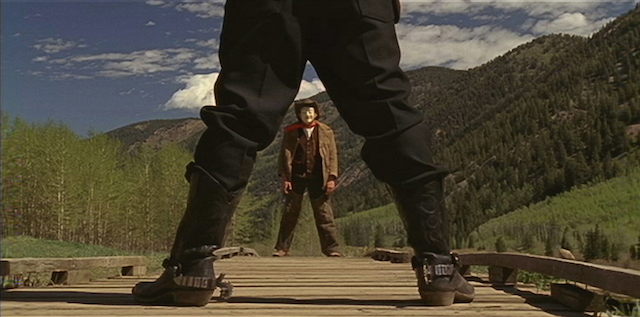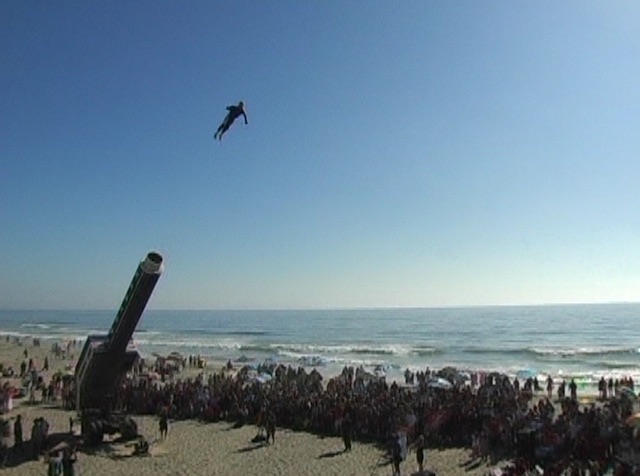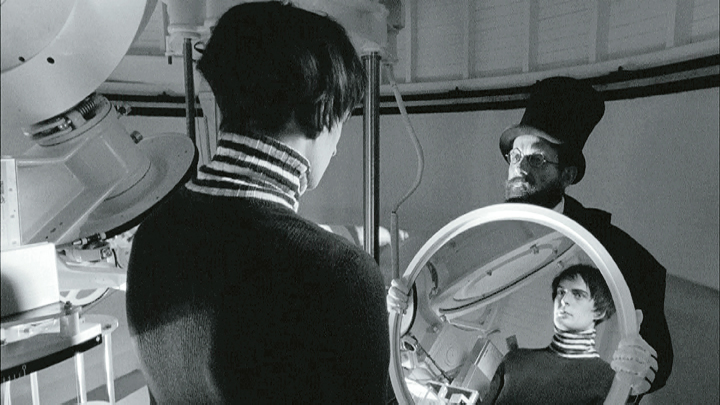From the beginning of the postwar era, when Africans in the French colonies were still prohibited by the Laval Decree from making films, French cinematographer and anthropologist Jean Rouch sought to ‘return the colonial gaze’. Working collaboratively with African actors and technicians, who improvised most of the plot and dialogue, he explored the limits of the self and the other. While Rouch is often cited as the founding father of Nigerian cinema, and his subversive and darkly humorous works are celebrated by members of the French New Wave, others see his output as deeply problematic. Far from decolonising African experiences, this white Frenchman, who had originally arrived in Niger as a colonial engineer, stands accused of recolonising them.
That Venezuelan artist Javier Téllez would align himself with Rouch’s work, as he has done on many occasions, is both understandable (the latter’s humour, subversion and most of all dialogic methodology are essential to Téllez’s work) and liable to put him in an equally delicate position. Téllez’s films aspire to destigmatise mental illness in the eyes of the self-proclaimed ‘sane’, while critiquing the institutional system that underpins its diagnosis and treatment. In works such as La Passion de Jeanne d’Arc (Rozelle Hospital) (2005), which frames the personal stories of female psychiatric patients within the drama of Joan of Arc, Téllez treads a fine line, creating unsettling films without (in most cases) falling into either exploitation or do-goodism.
Téllez started collaborating with residents of mental health institutions at the beginning of the 2000s. Featuring patients as actors and coproducers, the films riff on classic works of cinema, visual art and literature (most of his titles are either direct or slightly twisted quotations from the canon), their stories more or less modified depending on his collaborators. Mixing the familiar with the unfamiliar, Téllez complicates fixed definitions of madness and sanity, normality and pathology using a consistent methodology: the artist receives a commission from an international institution, finds a local psychiatric institution willing to take part, introduces his volunteer participants to the work being adapted (Sophocles’s Oedipus Rex in combination with the Western-movie genre, for instance, in Oedipus Marshall, 2006) and develops the script through collaborative workshops with the group, who then perform it for the camera. (Téllez often shoots his work on film, preferring the materiality of the medium, even if he’ll then transfer it to video for practical reasons.)

Architecture and the Foucauldian dynamics of space and power are recurring themes of Téllez’s work. The sinister hospital panopticon in O Rinoceronte de Dürer (Dürer’s Rhinoceros, 2010), which up until the year 2000 formed part of the Miguel Bombarda Hospital in Portugal, is one striking example: in this 40-minute film, day patients from the hospital imagine and perform what life would be like under the extreme restrictions suggested by the building’s design. Téllez sometimes extends those environments into the space in which his videos are shown, creating installation versions of the works (a circus tent for One Flew Over the Void (Bala Perdida), 2005, or the grottolike cinema for La Conquista de México, 2012). Yet these often feel unnecessary, and are perhaps here to ground the films’ presence in an art gallery. (Indeed, these are works that deserve a wide audience, and it would be interesting to see Téllez’s work move outside the ‘safe’ space of the gallery and into cinema auditoriums.)
The artist remembers a yearly festival held at the hospital where his father worked, in which patients would exchange their uniforms with the doctors and nurses, as a defining experience
Téllez is the son of psychiatrists and, because his father conducted sessions in the family home, sometimes with his son in the room, was surrounded from a young age by their patients. The artist remembers a yearly festival held at the hospital where his father worked, in which patients would exchange their uniforms with the doctors and nurses, as a defining experience. This carnivalesque reversal informs much of Téllez’s work, most evidently his 12-minute One Flew Over the Void (Bala Perdida). For that project, part of a commission for the 2005 InSite biennial on the Tijuana/San Diego border, Téllez collaborated with a group of patients from a psychiatric institution on the Mexican side to organise a protest-cum-carnival that questioned ideas of borders, physical and mental, by staging their transgression. Onscreen, demonstrators led by a trumpeter brandish placards protesting their own marginalisation and marching down the street towards a stage erected on a beach in front of a wall that marks the border. A crowd watches as the protesters don animal masks and, accompanied by a fanfare, pass through a hoop held by a man dressed as a ringmaster, a whip in his other hand. The film culminates with David Smith, a human cannonball, climbing into a monumental blue cannon, which, with a bang, propels him into the air and over the border wall. The crowd goes wild.


Javier Téllez, One Flew Over The Void (Bala Perdida) (stills), 2005, single-channel video projection, colour, sound, 11 min 30 sec. © the artist. Courtesy the artist, Peter Kilchmann Galerie, Zürich, and Koenig & Clinton, New York
Analysing the work of Rabelais in relation to folk traditions, Mikhail Bakhtin described the transgressive power of carnival as a communal event in which conventional boundaries are broken down through displays of excess and grotesqueness, in which the line separating falsehood from truth is contested. But the carnival is also a political event, seen by the established order to provide the popular catharsis necessary to maintain the status quo. The festivities conceal a strategy of control, and it’s that ambiguity in the power dynamics underpinning Téllez’s collaborations that triggers unease in the viewer – is this exploitation? Are the participants aware of the implications of their being cast as circus performers?
The festivities conceal a strategy of control, and it’s that ambiguity in the power dynamics underpinning Téllez’s collaborations that triggers unease in the viewer – is this exploitation?
This idea of a world turned upside-down – where beggars can become kings and the mentally ill are celebrated for their wisdom – is also at play in the 2008 work Caligari und der Schlafwandler (Caligari and the Sleepwalker), an adaptation of Robert Wiene’s 1920 silent horror classic The Cabinet of Dr Caligari commissioned by Berlin’s Haus der Kulturen der Welt for the Rational / Irrational exhibition (2008). Wiene’s film was one of the earliest attempts to represent insanity on screen, and as such belongs to the larger corpus of works responsible for shaping our perception of mental illness that Téllez sets out to challenge. Téllez’s 27-minute film, then, developed with patients from the Viviantes Klinik in Berlin, retains the film’s key role-reversal between psychiatrist and patient, sane and insane, but shifts away from horror (in Wiene’s film, Caligari is a mad hypnotist who uses one of his patients to commit murders) to a more poetic relationship in which Caligari attempts to ‘wake’ the sleepwalker, who claims to come from a planet where everyone is mentally ill. (There are even comic moments, such as the quirky geography lesson during which each country on the map is identified according to its most prescribed drugs: ‘The United States of Prozac’, ‘Atozil’, ‘Socialist Republic of Diazepam’, etc.) Téllez insinuates another level of ‘reality’ through footage of the Viviantes patients in a movie theatre watching Wiene’s film, while their words can be heard occasionally as voiceovers throughout the film – “I know I’m having a psychotic episode when I feel I’m in a different film,” one confesses – and, ultimately, Caligari’s effect stems from the confusion it creates within the viewer’s mind as to who’s really ‘awake’.

Javier Téllez, Caligari and the Sleepwalker (still), 2008,Courtesy the artist and Galerie Peter Kilchmann, Zurich © the artist
Over the years, Téllez has expanded his interest in alternative perspectives by engaging with other marginalised groups: borrowing its title from a work by philosopher and art critic Denis Diderot, and based on an ancient Indian parable, Letter on the Blind, For the Use of Those Who See (2007) films six sight-impaired participants as they encounter an elephant for the first time, each describing their experience based on familiar references (the skin is alternately described as an ‘old warm tyre’, ‘a hairy couch material’ or ‘thick lizard skin’); Shadow Play (2014, which lends its title to the artist’s current exhibition at the Guggenheim Museum, Bilbao) was developed with refugees, and is a poetic narration of the experience of exile using the symbolic language of shadow play. Most recently Téllez worked with the Tarahumara in the sierra of Chihuahua, in Mexico, for To Have Done with the Judgment of God (2016), in which members of the indigenous group are filmed going about their everyday lives as they listen to a translated version of Antonin Artaud’s 1946 radio piece by the same name. Nothing much else happens, however, and the work soon feels more like an ethnographic film than a collaborative project, in which Western narratives are superimposed onto a non-Western culture.
A critique of colonialism, seen in parallel to the institutionalisation of the mentally ill – as a form of subjugation of the ‘other’, legitimised through the theorisation of racial (or intellectual) superiority – runs through La Conquista de México. Commissioned for Documenta 13, the 45-minute film stars outpatients from a psychiatric hospital in Mexico City, who alternate between playing the parts of interned patients in that same institution (whose holding conditions are more akin to a prison) and historical characters in a reenactment of the conquest of Mexico by Hernán Cortés in 1519, filmed on the pyramids of Teotihuacán. The work was inspired by Antonin Artaud’s 1934 critique (from which Téllez’s work derives its title) of the subjugation of the Aztec people in a play originally intended for the former’s Theatre of Cruelty (Artaud was himself institutionalised for long stretches of his adult life, and is a totemic presence in Téllez’s films). It culminates in a speech by one of the characters, who, standing on a theatre stage wearing a suit, condemns the absolute authority of psychiatry over the lives and freedom of the ‘mad’, contending that what is called ‘mental illness’ should be treated as an equally legitimate concept of reality to that labelled ‘sanity’. The dramatic intensity drops, however, as the camera zooms out to reveal an empty room; in the final scene, the patient is walked back to his bunk by a nurse. That no one is there to hear the compelling case made for a change of attitudes towards mental illness seems deplorable – yet ultimately, it is the gallery audience that the film (and the speech) were intended to reach.

Theatre – to quote Artaud’s ‘Theatre of Cruelty’ (1933) – should ‘succeed in organically reinvolving man, his ideas about reality, and his poetic place in reality’. This belief that art should aim for the spiritual transformation of man, not so much by ‘raising awareness’ as by unsettling established ideas and perceptions in the mind of its audience, lies at the core of Téllez’s work. His extensive quoting and referencing of the myths of our contemporary culture, then, falls within this approach. Proposing a form of critical subversion, Téllez hijacks and twists assimilated narratives and motifs, using their familiarity to the benefit of less familiar stories and perspectives. And in a society increasingly wary of the imagined ‘other’, Téllez’s aspiration to a less binary, more complex understanding of different realities is welcome.
Javier Téllez: Shadow Play is on view at the Guggenheim Museum, Bilbao, through 18 November
From the September 2018 issue of ArtReview
